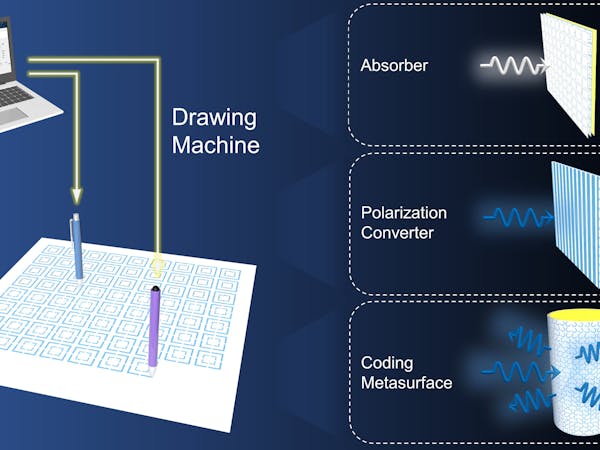An automatic drawing machine to produce paper metamaterials
Metamaterials are described as synthetically created composite materials whose structured microstructures, rather than the chemical constituents of the materials, determine their properties. In other words, they are engineered materials with properties not found in nature. Researchers at Nanjing University have capitalized on these properties by designing a automatic drawing machine which uses pens and pencils to transfer metamaterials onto paper.
A new paper from this team describes their new technique, which uses a ballpoint pen with conductive ink to draw conductors and mechanical pencils to draw resistors and resistive films. These have been incorporated into a computer controlled drawing machine which makes the deposition process more automatic with increased precision. “Although paper-based metamaterials have already been manufactured using inkjet printing technology, our drawing technique is cheaper, simpler and more flexible,” says Junming Zhao, head of the research team. “Our method could be useful for fabricating reconfigurable metallic antennas and lenses as well as metamaterial devices that absorb incident electromagnetic energy from cell phones or other sources.”
The machine is equipped with three stepper motors, two of which are used to move the pen or pencil in a horizontal plane, and the third is used to raise or lower the writing instrument in a vertical plane. A computer regulates the characteristics of the drafting machine, including travel speed, much like a CNC machine. Using these conductive ink pens and graphite pencils, the researchers created three paper-based materials, including a polarization converter, an absorber, and a conformal coding metasurface, using their unique drawing technique.
The researchers used their new approach to create a conformal coding metasurface. (📷: Junming Zhao / Nanjing University)
They demonstrated that the polarization converter could rotate the polarization linearly by 90° between 3.1 and 6.6 GHz with a conversion efficiency of over 90%. The absorber weighed only 58.3 g and had a 90% absorption capacity between 2.1 GHz and 10.5 GHz, while the metasurface was developed for radar cross-section reduction, a technique for conceal the radar signal in ships and aircraft used by the military.


Comments are closed.